In March 2021, Geldingadalir volcano in Iceland started to erupt for the first time after 870 years. It continued to erupt for 6 months, until it stopped in September 2021. We are grateful for being able to go there in May and stand just a few hundred meters away from the crater and a couple feet from the flowing lava.
Yesterday, it started to erupt again. A fissure of about 300m opened in the ground and lava flows continuously out of it. Over 1000 people rushed to go there in the first day, although the Icelandic authorities advised to wait a couple of days until they are able to assess the situation and put in place some safety protocols. We understand the excitement to go and stand next to a volcano, but it’s important to do that safely and without putting your life, and the life of persons that might come to rescue you, in danger.
Here are the things that we did back in 2021 when visiting the Geldingadalir volcano in order to stay safe and to visit the volcano without creating any troubles.
Inform yourself about the current situation
First of all, it’s important to follow the instructions provided by the authorities. They have the experts and they know what is in the best interest of the people that might want to go and see a volcano. The best source to inform about the status of the volcano and if it is advisable to go there is SafeTravel.is which is the official Icelandic website for staying safe in Iceland. They provide details about the current situation and wherever you can go there or not. The eruption in Reykjanes article usually has the most up to date info about it. If they say don’t go, don’t go!
Other sources of information are the local newspapers and publications that keep a close eye on the authorities’ announcements. We read Grapevine.is and IcelandMonitor.is. They are small publications (well.. everything is small in Iceland) that publish the most important news from Iceland. Today, Grapevine just posted some first photos with the new eruption and they look stunning.
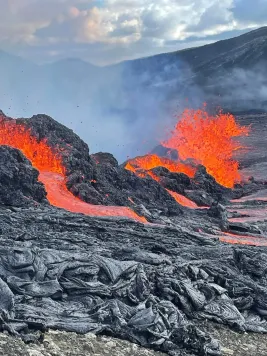
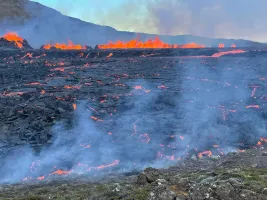
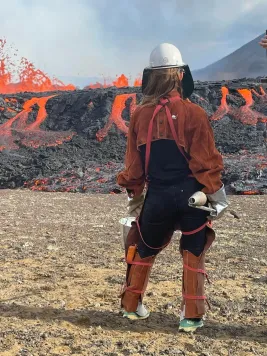
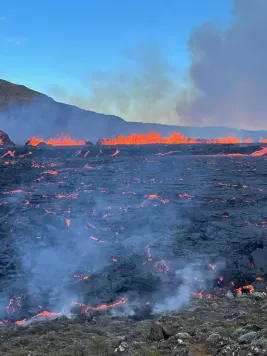

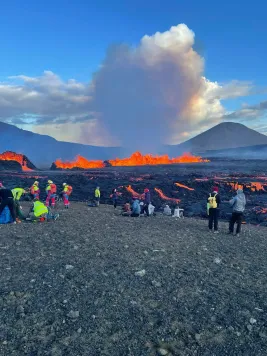
Keep an eye on weather and winds
One of the greatest threats of going to see a volcano are the gases that come out of it which are toxic to humans. Winds play an important role in dissipating the gases and you should never go there without checking the wind direction. You don’t want gases to come in your way. The best way to do it in Iceland is by checking the local website Weather.is. It is a great website for checking the quick changing weather of Iceland and most of the times, it is more accurate than the traditional weather apps.
Additionally, it’s recommended to always stay on higher grounds because the toxic gases usually tend to accumulate in lower areas such as valleys. I remember that in 2021, a few weeks after the eruption has started there were some news about people starting to feel sick and having troubles getting back from the volcano because of a sudden wind change. Thankfully, no one’s life has been in great danger, but there were people whom required medical assistance.
Let others know about your plans
If you get in trouble, it is best to get help as soon as possible. In Iceland it is easy to get yourself into an area without phone signal and where it would be very hard for someone to reach you. Thus, when we’ve been to the volcano in 2021, we always informed someone close to us about our plans and when we’re going to return. If we wouldn’t confirm them that we’re back safe in time, then they would have called the Icelandic authorities.
You can also do that without bothering your appropriates by using the Safe Travel Trip Monitor. On the website, you complete a form with all the details about your plan and with a phone number where to confirm when you’re back. If you don’t confirm that you’re back safe within the specified timeframe and you cannot be reached, then the rescue teams will start looking for you. It’s a smart system and I wish it would be available more broadly.
Equip properly for the hike
The weather in Iceland is changing so fast, and there is a saying for it between locals. It goes like this: “if you don’t like the weather, just wait 5 minutes”. We’ve been in Iceland many times and we can confirm that it stands true. Sometimes you might be lucky and have plenty of sunshine for hours, but you should always be prepared for cooler days with rain and strong winds. The first time we’ve been to the volcano, we had snow, sun and then rain, all in a matter of hours.
We would recommend to always pack for cold weather in Iceland and have a few layers that you can put on and off depending on how the weather goes. We wrote an article about the hiking gear that we use during cold weather and it is pretty much what we had with us when we did the hike to the volcano.
Take with you enough food and water
The hike to the volcano is quite long and strenuous because on some parts of the path you have to walk through old lava fields which are not an easy walk. We read some articles about people underestimating the distance and going there without water or food. We recall this story that we read last year, when a father and his son went to the eruption without water and they got lost. They’ve been wandering around trying to find the way back for several hours and when the rescue team found them, the son was in shock.
We always pack with us more water than we might need and we try to take some snacks that would give us energy for the additional effort that we might have to do. Also, in Iceland the temperatures can be quite low, so it’s best to carry the water in an insulated water bottle so it says warm.
Add to your backpack a gas face-mask
As we said above, the gases from the volcano are one of the greatest threats. We packed in our backpack a proper gas face-mask. Luckily, the weather was good and the gas amounts weren’t that large when we’ve been there, but we used them once because there was a lot of smoke coming from the moss burned by the flowing lava. It was not necessarily not being able to breath, but more about feeling small itches in our eyes.

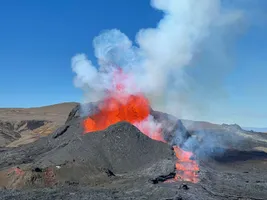
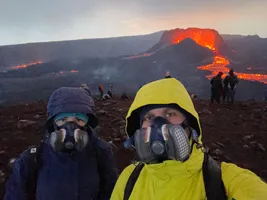
Don’t step on lava
It might sound like an obvious thing, but there are plenty of people doing that. From time to time, a news appears about some people that thought they could walk on the lava and put their life in great danger. New lava, and that means even lava from an eruption from a few years ago, is not safe to walk on because there might be huge wholes that you could fall into. When lava flows, the layer which is closer to the air solidifies faster and that turns into tunnels through which the hot lava flows.
The new lava is very hot and it is hard to even stay a few meters close to it for longer than a few seconds. Also, trying to record it is a challenge because the devices overheat and they stop working.
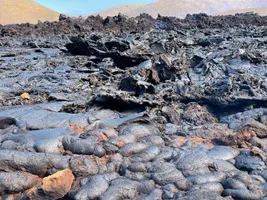
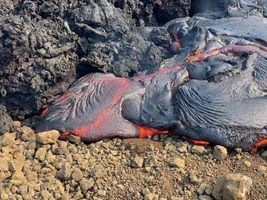
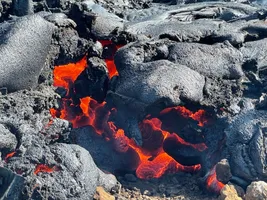
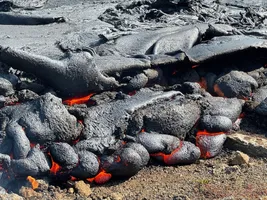

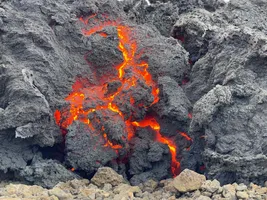
Always keep a safe distance
When we’ve been to the erupting volcano in Iceland, you could go very close to the volcano. I would estimate that the closer you could get was 100m to the big crater. Though, there were some marks put in place by the rescue teams which were much further away. If you see such signs, please don’t go closer even if you see people there. It doesn’t worth putting your life in danger just to take a close photo - you could as well just use the zoom function from your photo devices. Also, here is a tip: standing on a hill will make you appear closer than you actually are.
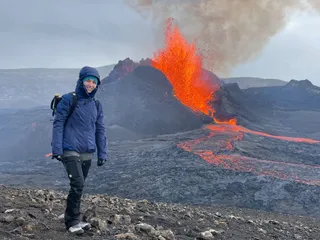
If you intend to go and visit the volcano, please stay safe and never put your life in danger just for the sake of seeing a thing or taking a better photo. While we tried to highlight the top things that would keep you safe, always check with the latest advice from the authorities and follow what they say.
 Travelfoss
Travelfoss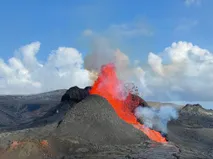
Stay safe and let us know in the comments below if you’ve been there and how it was.
Related Travel Articles
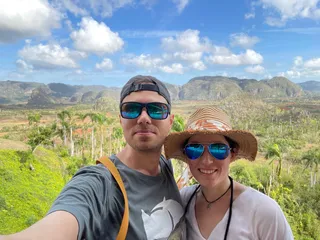
Writing free, independent and personal travel content since 2021. If you appreciate what we do, then you can return the favor by using the affiliate links below.
- Get your accommodations on Booking.com
- Buy your gear and gadgets from Amazon
- Book flights using Expedia
- Book activities on Get Your Guide
- Book guided trips on G Adventures
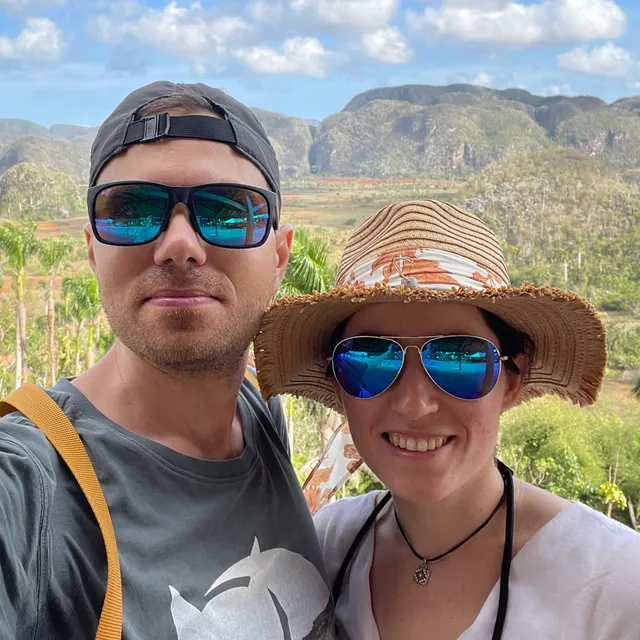
Writing free, independent and personal travel content since 2021. If you appreciate what we do, then you can return the favor by using the affiliate links below with no cost for you.
